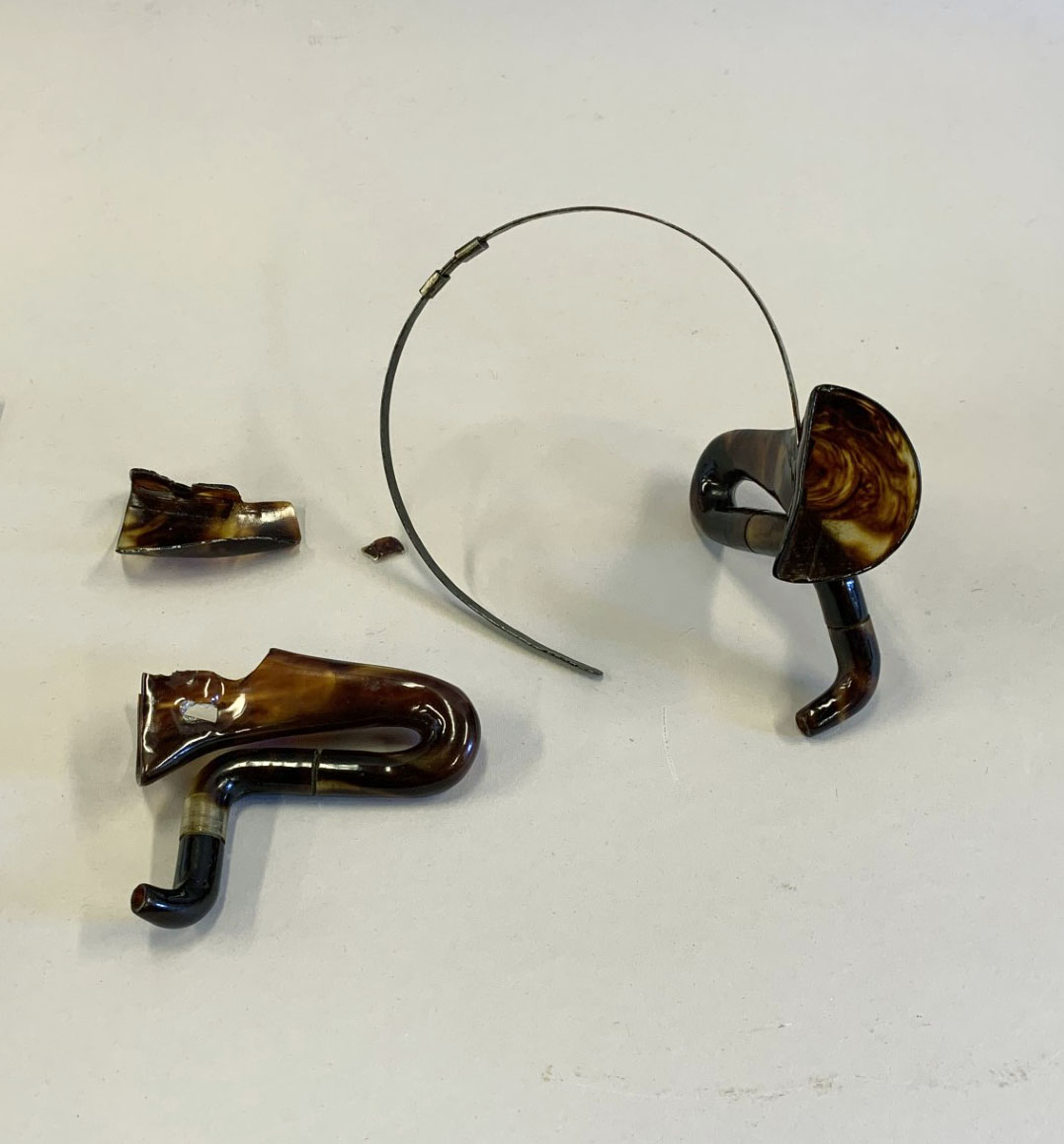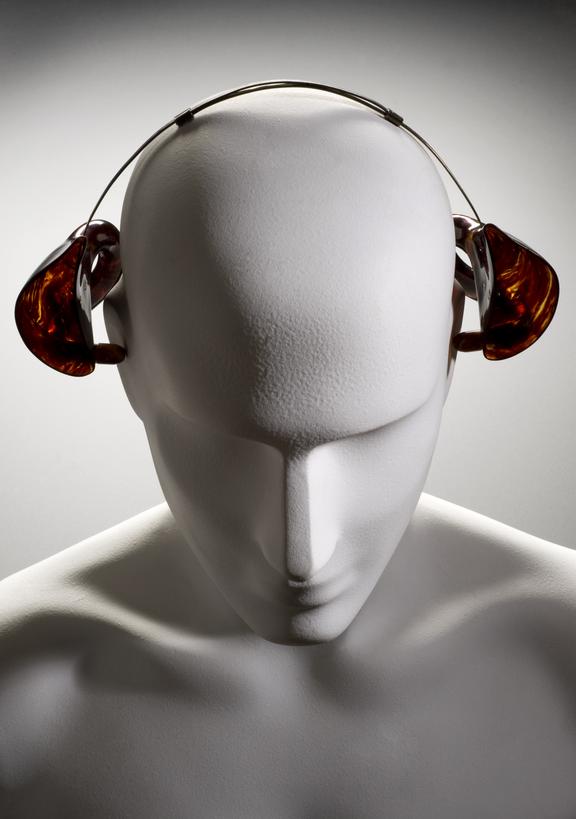Exploring Stakeholder Consultation in the Co-Conservation of Hearing Aids
11 December 2023How should we conserve a hearing cornet from the Museum of Cardiff?
The Museum of Cardiff seeks to explore the city’s heritage through the stories of its people (Museum of Cardiff, 2023). Its collections are largely donated by local people and community groups. The institution’s dedication to social issues and the local community is evidenced through its work and co-curated displays with advocacy groups such as Cardiff People First (Cardiff People First, 2018). Its co-curated exhibitions are mirrored by other institutions such as the People’s History Museum in Manchester (Enckevort et al. 2023). However, the work of co-curation does not necessarily extend to co-conservation.
Medical and disability objects are often in collections with little to no contextual information attached, an issue which has in recent years been explored in such projects such as Mat Fraser’s Cabinet of Curiosities (School of Museum Studies, 2022). Many museums are seeking to improve not only accessibility and representation of their disabled visitors and employees, but the consideration of representing of disabled people within the collections themselves remains to be explored further (Rosenstein, et al. 2010). This can be difficult when often these objects have little information attached, dissociating them from their context.

Within the Museum of Cardiff’s collection resides a headband hearing cornet, with little more information attached to it than the name of the donor. The museum has kindly provided this object to be the focus of my MSc Dissertation. In an effort towards co-conservation the Museum and I have discussed a variety of treatment options for their collections hearing cornet. A number of these options have now been pre-approved, and the Museum is happy for me to work with the one my research settles on as the most suitable. The museum’s lack of strict conservation requirements allows a freedom to explore how conservation decisions can be impacted by stakeholder involvement.
An object can hold different meanings and significance for different people, and consulting with a variety of stakeholders can be beneficial when exploring the value of an object or collection, particularly when it is linked to a particular community or demographic (Lupi, 2020. pp.84-92). Henderson (2020, p.196) argues that the conservator acts within wider society, where they have the (often missed) opportunity to engage with contemporary issues (Henderson 2020, p.197; Balachrangran, 2016).
The object’s history as a used hearing aid lends to its complex intangible value. I exist on the periphery of the D/deaf and hard-of-hearing community, as someone who has a disorder which provides difficulties in differentiating and processing sounds and words. The experiences of D/deaf and hard-of-hearing people are very personal, varied, complex, and sometimes conflicting. Through carrying out in-depth interviews, I hope to gain knowledge of their perceptions on hearing aids (past and present), museum displays, representation in heritage, and the issues of the medical gaze. This engagement with those who identify as D/deaf and hard-of-hearing will inform the conservation treatment of the hearing aid.
The Museum has pre-approved conservation treatment options, such as re-adhering the pieces and repackaging, but also 3D scanning and creating a 3D model. During the interviewing process, these possibilities have been offered, and we have discussed treatment they would prefer for the hearing aid to go through. These discussions will inform a significance assessment which will explore the tangible and intangible value of the object, which in turn will inform my conservation decision making alongside considerations of materials, for example.


By questioning my perceptions of conservation through stakeholder engagement, I hope to acknowledge the context in which the object exists and understand that there are multiple options which can be considered for the object future and explore who these may be best for (Henderson et al, 2023, p.8).
The history of hearing aids and treatments for hearing loss has been littered with hearing perspectives of D/deafness and the pursuit of ‘normalcy’. Hearing aids have been used for centuries, and stigma, conflicting pressures to use them or not, and efforts to conceal their use have been around for just as long. Centring the perspectives of the D/deaf and hard of hearing will allow for the object to be re-associated and put into context, as well co-conserved with a consideration for the representation of those who may use them, may not want to use them, and those who might use them in the future.
My great thanks goes to the Museum of Cardiff for enabling my research and for their engagement with the local community and marginalised demographics to encourage representation of diverse stories in heritage.
References
Balachandran, S. (2016). ‘Race, Diversity & Politics in Conservation: Our 21st Century Crisis’. Paper presented at the 44th AIC Annual Meeting). Available at: http://resources.culturalheritage.org/conservators-converse/2016/05/25/race-diversity-and-politics-in-conservation-our-21st-century-crisis-sanchita-balachandran/. [Accessed on 14th April 2023].
Cardiff People First (2017). People with a Learning Disability: Taking Control of Our History. Available at: https://www.cardiffpeoplefirst.org.uk/wp-content/uploads/2021/03/cpf_takeover_evaluation.pdf. [Accessed on 20th March 2023].
Enckevort, J. and K. Rumsey (2023). ‘Nothing About Us Without Us’. In Iconnect. (1). Pp.28-31.
Hayha, H., Jantunen, S. and L. Paaskoski. (2015). Analysing Significance. [Online] The Finnish Museums Association. Available at: https://icomfinland.fi/app/uploads/2022/05/Analysing-Significance.pdf [Accessed 20 Feb. 2023].
Henderson, J. (2020). Beyond lifetimes: who do we exclude when we keep things for the future? Journal of the Institute of Conservation, 43(3), pp.195–212. doi:https://doi.org/10.1080/19455224.2020.1810729.
Henderson, J. (2022). Conservators Delivering Change. Studies in Conservation, 67(sup1), pp.105–111. doi:https://doi.org/10.1080/00393630.2022.2066320.
Henderson, J., Lingle, A. and Parkes, P. 2023. ‘Reflexive autoethnography’: Subjectivity, emotion and multiple perspectives in conservation decision-making. Presented at: ICOM-CC 20th Triennial Conference, 18-22 September 2023 Presented at Bridgland, J. ed.Working Towards a Sustainable Past. ICOM-CC 20th Triennial Conference Preprints, Vol. 20. Paris: ICOM
Lupi, T.Z. (2020). Conservation is About People. Conservation Insights 2020, pp.82–94.
Museum of Cardiff. “Cardiff Story Museum – a Museum All about Cardiff.” Cardiff Story, 2023, cardiffmuseum.com/. Accessed 10 Dec. 2023.
Rogers, V. (2018). Cardiff Story Museum: Conservation and Collection. https//cardiffmuseum.com/s Care Policy. Museum of Cardiff.
Rosenstein Werb, S. and T. Hartman Squire (2010). ‘Transforming Practice: Disability Perspectives and the Museum’. In Re-Presenting Disability; Activism and Agency in the Museum. London: Routledge.
School of Museum Studies (2022). Mat Fraser Cabinet Of Curiosities. [online] www.youtube.com. Available at: https://www.youtube.com/watch?v=3RVaVRXK15E.
Science Museum Group. “Acoustic Headband with Ear Trumpets | Science Museum Group Collection.” Science Museum Group Collection, collection.sciencemuseumgroup.org.uk/objects/co8599286/acoustic-headband-with-ear-trumpets-aural-aid. Accessed 23 Mar. 2023.
Virdi, J. (2020). Hearing Happiness. Chicago: University of Chicago Press.
Washington University School of Medicine (2009). Concealed Hearing Devices of the 19th Century. [online] beckerexhibits.wustl.edu. Available at: https://beckerexhibits.wustl.edu/did/19thcent/index.htm.
- March 2024 (1)
- December 2023 (1)
- November 2023 (2)
- March 2023 (2)
- January 2023 (6)
- November 2022 (1)
- October 2022 (1)
- June 2022 (6)
- January 2022 (8)
- March 2021 (2)
- January 2021 (3)
- June 2020 (1)
- May 2020 (1)
- April 2020 (1)
- March 2020 (4)
- February 2020 (3)
- January 2020 (5)
- November 2019 (1)
- October 2019 (1)
- June 2019 (1)
- April 2019 (2)
- March 2019 (1)
- January 2019 (1)
- August 2018 (2)
- July 2018 (5)
- June 2018 (2)
- May 2018 (3)
- March 2018 (1)
- February 2018 (3)
- January 2018 (1)
- December 2017 (1)
- October 2017 (4)
- September 2017 (1)
- August 2017 (2)
- July 2017 (1)
- June 2017 (3)
- May 2017 (1)
- March 2017 (2)
- February 2017 (1)
- January 2017 (5)
- December 2016 (2)
- November 2016 (2)
- June 2016 (1)
- March 2016 (1)
- December 2015 (1)
- July 2014 (1)
- February 2014 (1)
- January 2014 (4)